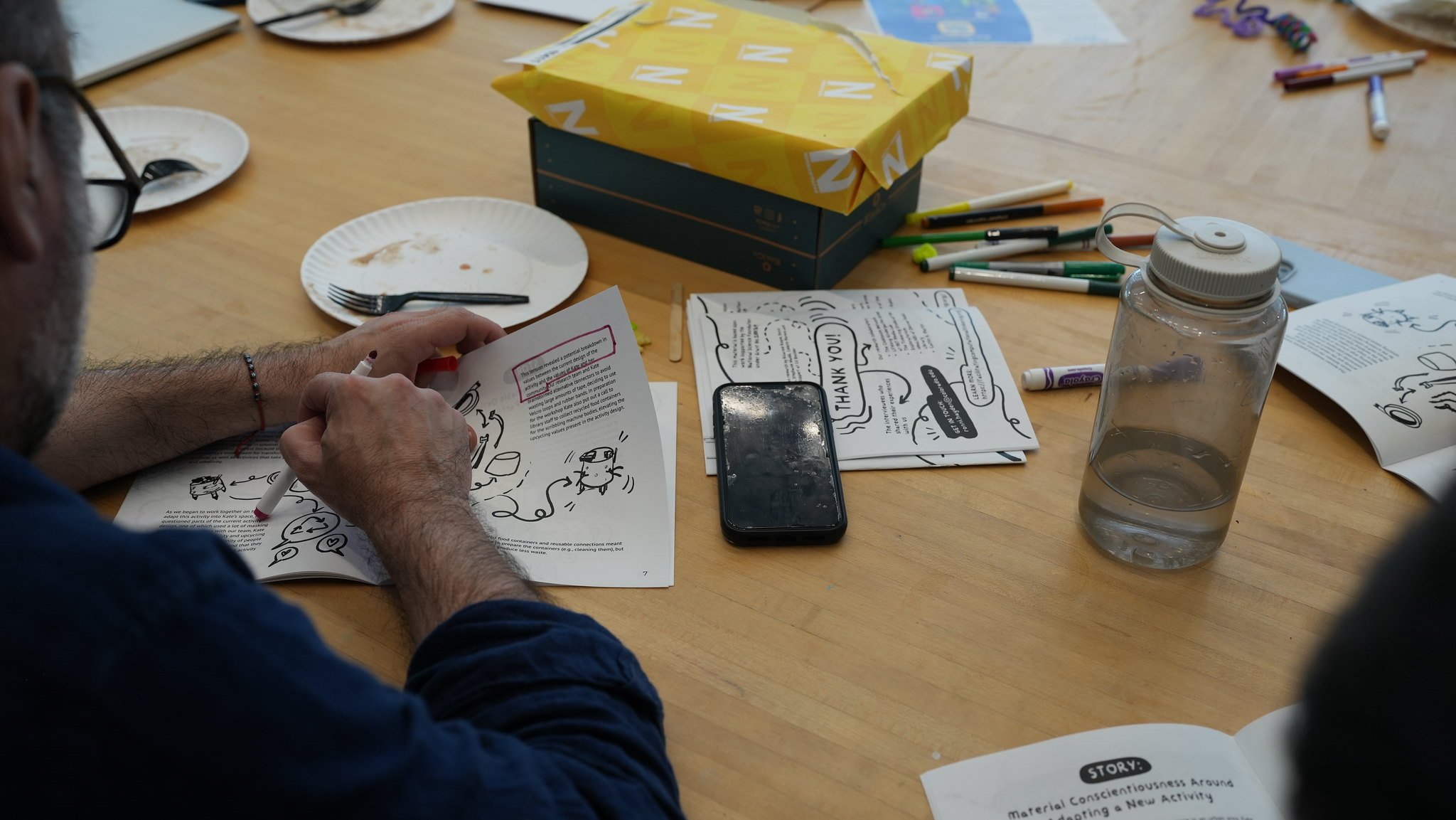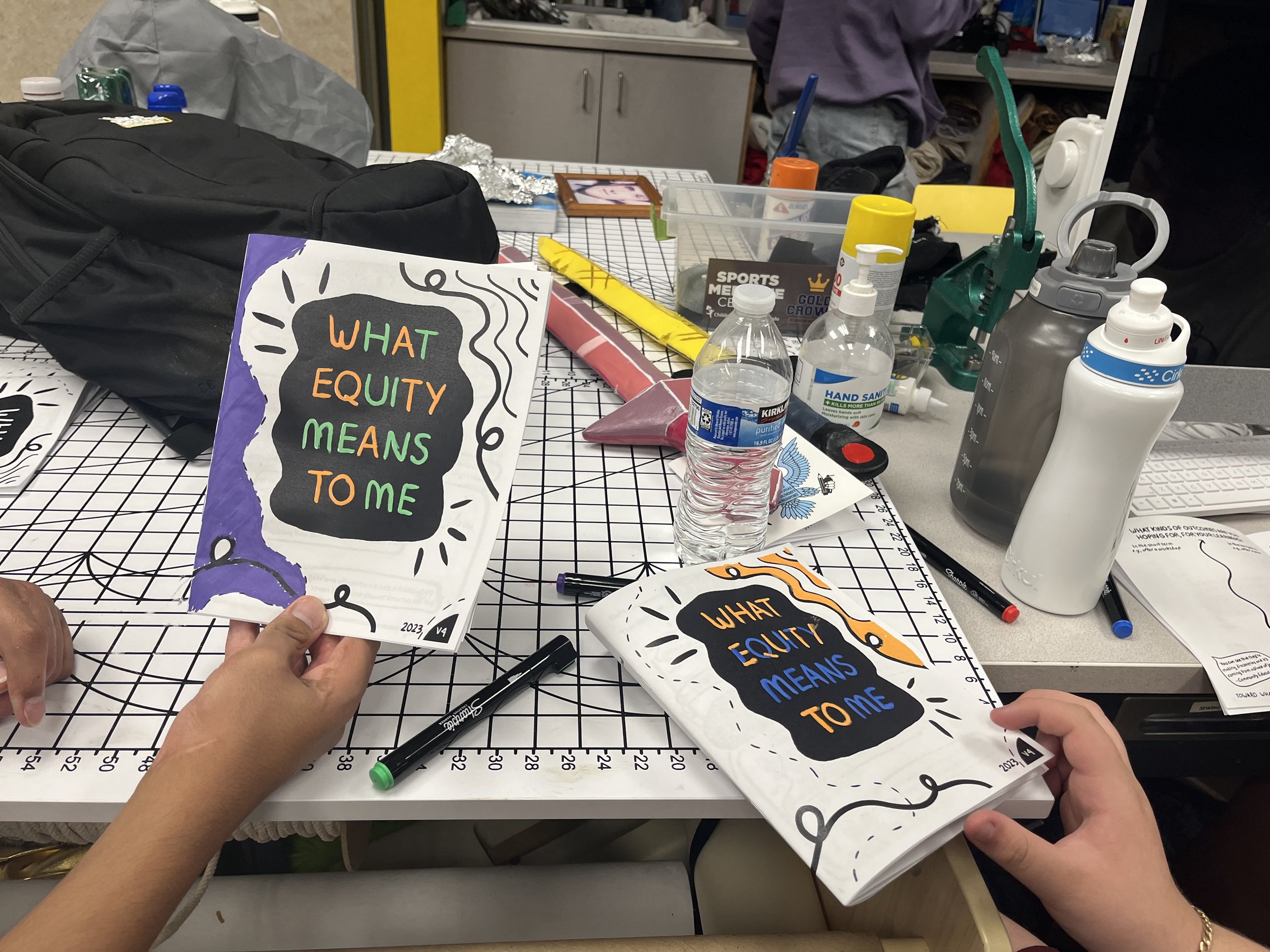Introduction
If you are familiar with our work or have met our team at conferences, you may have come across our interactive “What Equity Means to Me” zine (formerly “Equity as a Moving Target”). We have more recently started sharing our “Now What” zine that focuses more on supporting the implementation and sustainability of learning innovations . Making and sharing these zines has been really rewarding for our team and met with so much enthusiasm from participants that we are currently scheming about how we can make even more.
But before we come out with more of our research in this format, we wish to address the question: why zines?
What is a zine?
A zine (pronounced zeen) is a small-batch circulation of self published work, often in the form of text or images. They are easily reproducible and come in all shapes and sizes, but are most often seen in the form of a stapled or bound paper booklet.
The ACM Designing Interactive Systems (DIS) 2024 conference’s zine library with our Equity zine in the bottom shelf
People make zines in almost any format, from comics to poems to collages to stories and more. They can be made by a singular person or a collective of people and topics range from advocacy and activism to sharing a collection of art. In other words, you can make a zine about anything you want!
History of Zines
The name “zine” originated in the 1930s from sci-fi fans in Chicago in response to heavy scrutiny and dissatisfaction with the quality of press-published science fiction writing. Fans made “fanzines” of their own sci-fi writing and sold them at science fiction conventions (that’s right! It’s not a shortened version of “magazine”). However, self-published booklets have been made by people as far back as the 1400s to share and spread information, such as guides on practicing witchcraft or Martin Luther’s Ninety-Five Theses.
Zines have also been a major part of grassroots movements of resistance and have served as spaces for marginalized groups to share commentary, organize movements, and create art together. “Little Magazines” emerged from the Harlem Renaissance literary movement in the 1920s. They created a forum for black creatives and activists to share their work and thoughts with audiences both locally and nationally, depending on the distribution of the publication. These zines featured topics ranging from poetry and writing to experimental essays, radicalist texts, and critiques of politics, leaders, and white culture.
In the 1990s, riot grrrl emerged as an underground feminist punk movement associated with “third wave” feminism. Centered around feminism, punk music, and politics, the riot grrrl movement also published many collage zines where women shared their experiences with sexual assault, body image, mental illness, discrimination, and other topics associated with being a woman.
As self-published pieces, zines have a history of being a tool and creative space for people who don’t have access to traditional printing methods to share their thoughts, work, and opinions. It is not only a piece of media to consume, but also a way to build community and find a space to come together.
Why we choose to make zines
So why do we, a university research group, choose to make zines? The Equity Zine, our very first zine, actually came out of a desire to share back our research findings with the educators who participated in interviews about what supports them in doing equity-oriented computing activities in their spaces. During these interviews, we found that many informal educators had explicit conceptions of equity that were broad and differed across organizations but implicitly they described sophisticated equity moves as they talked about their practice. When we shared the preliminary findings with participants and their colleagues, we found educators engaging in productive tensions around their conceptions around equity and sharing concrete strategies. We realized there was an opportunity to create a tool that supported educators in making their thinking around equity more explicit and scaffolding conversations with their peers. We designed the Equity Zine: an interactive way for educators and facilitators to identify and reflect on the different dimensions of equity in their spaces and how they have been thinking about it.




Over the last two years, the Equity Zine has gone through many iterations, workshops, and rounds of feedback from educators at conferences and at our partner sites. Our main piece of feedback about the zine has been that it makes equity, a complex and sensitive topic, approachable, concrete, and a collaborative discussion. We have even seen facilitators take our equity zine and remix it for their own use, such as sharing it with teens or bringing it to their staff meetings!


Zines are also easy to make and distribute compared to other printed book-esque materials. We can quickly print them on our printer and assemble them in our office space by ourselves. If somebody else wishes to print our zines themselves, they can download the file from our website and brief print instructions.
While our zines could easily be described as “workbooks”, we feel that the subject matter – as well as our own personal values – holds more connection to the meaning and sentiment behind zines. We also see our zines as malleable and hope that people will remix them to fit their different needs and spaces. The hand-drawn aesthetic designed by Celeste is meant to create a sketchy, brainstorming feel to the zine. We want people to make it their own and know that the work is continuous even after participating in a zine workshop with us. As a result, we wish to express and honor that history when using the name “zine”.
For our team, zines are one way that we try to move our research outside of the academy, and get it into the hands of as many people as possible in a way that feels approachable and useful.
Helpful Tips
Here are some tips that we’ve learned along the way that might be useful for those looking to turn their own research into zines.
Iterating and reflecting: Your first version of your zine will not be your final (and neither will your second, or your third, or your fourth… or maybe ever). Through sharing with different groups of educators and facilitators and gathering their feedback, you can learn what works and what doesn’t and make adjustments from there.
Highlighting other voices: Our ideas behind our zines are not new ones – equity and infrastructure have long been researched, discussed, taught, and shared. We try to highlight diverse voices who are experts in the field in our zines to add to the depth, knowledge, and resources the people using our zines can find.
Invest in a booklet stapler: Because we chose to print our zines on legal size paper, standard size staplers were not big enough to properly staple. A booklet stapler was a worthwhile investment and also is designed to help easily staple onto the fold.
Try out Figma (a collaborative digital design tool): If you have a school email address you can get a free professional Figma plan. Putting our zines on Figma meant that multiple members on the team could look at it, tweak text, make comments, and share the in-progress draft with others.
Make sure your zine is readable in black and white: We designed our zine to be exclusively black and white to make it easier to print on different printers, especially if color printing is not available.
Have fun! If you’re not having fun with your zine people may be less likely to be engaged with it.
Make your own zine!
Zines don’t have to be a perfect, polished piece of work. They can be as casual as stick figure sketches or random thoughts on a bus ride home. While many booklet-format zines are stapled, there is a way to make a staple-free zine out of a single piece of paper. I (Mimi) like to make these out of pieces of scrap paper and carry them around to put random flashes of inspiration or doodles in.
You can use any size of paper as long as it is rectangular. Feel free to experiment and see how different sizes and materials result in different zine shapes!
These materials are based upon work supported by the National Science Foundation under Grant No. (2005764).
References
https://en.wikipedia.org/wiki/Zine
https://staples-alanna.medium.com/a-brief-history-of-zines-and-why-you-should-make-one-f362b30e6d67
https://guides.library.cornell.edu/zines101/history
https://bookriot.com/harlem-renaissance-little-magazines/
https://en.wikipedia.org/wiki/Riot_grrrl
Places in the Denver metro area to find zines:
https://denverzinelibrary.org/
Also check out local libraries, coffee shops, and bookstores!










